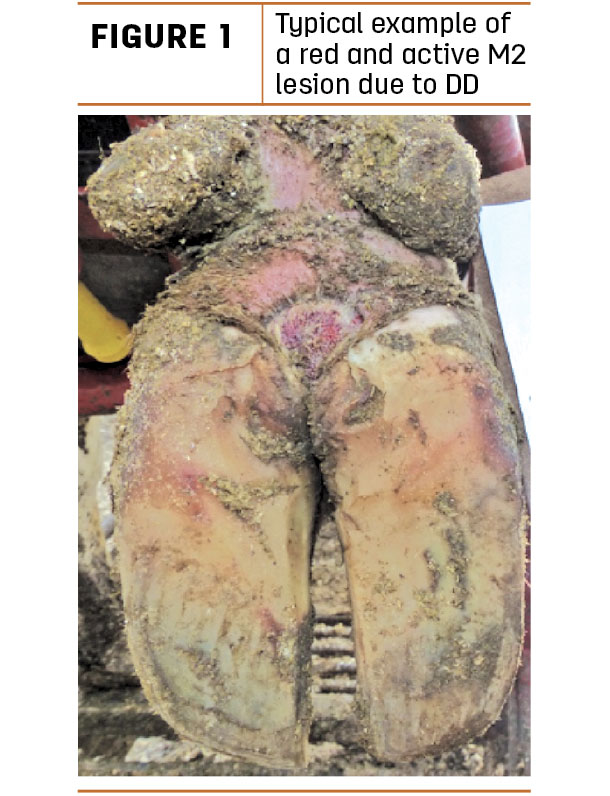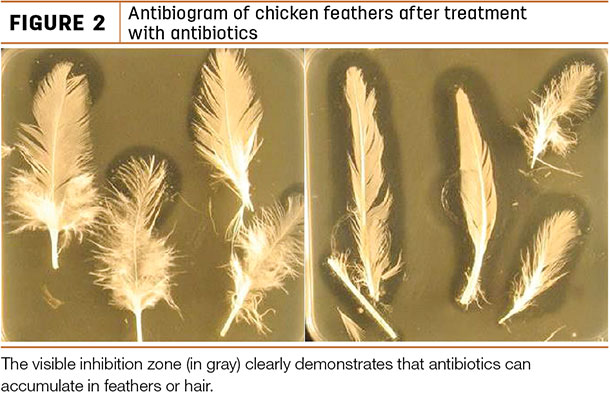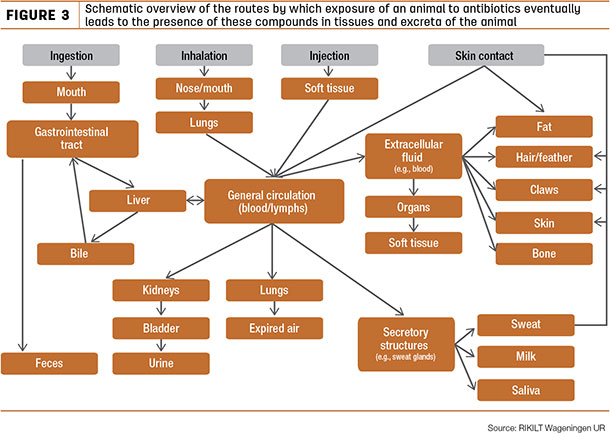Claw lesions, such as those due to digital dermatitis (DD, hairy heel warts, Figure 1), are a serious problem in dairy cattle herds worldwide and often cause lameness. Treatments for DD include a large variety of products, used at both the herd level and the individual level, and these often involve the application of antibiotics.

The use of antibiotics in food-producing animals is now increasingly regulated. For this reason, antibiotics often have to be prescribed by veterinarians, and their use has to be recorded in detail. However, in many countries, hoof trimmers and farmers still routinely buy and apply antibiotics on their own.
In the past, locally and topically applied antibiotics were assumed not to penetrate the skin barrier when administered to the hoof. Thus, the risk that antibiotic residues would enter the bloodstream and end up in the milk following topical application was considered negligible.
The amounts of antibiotics allowed in milk, eggs and meat is set at a maximum residue limit (MRL) value. Below this MRL value, no health effects are expected for the general public, based on current knowledge. In Canada, the MRL value for tetracycline, an antibiotic often used to treat hoof problems, is 100 µg per kilogram (equivalent to 100 parts per billion).
A wait time is often imposed after use of an antibiotic before milk from a treated animal is allowed to be used for human consumption.
One randomized clinical trial conducted in 1999 investigated whether the topical treatment of claw lesions with tetracycline leads to residues in milk.
The investigators used high-performance liquid chromatography but detected no antibiotic residues at that time. However, detection techniques have improved since then.
In 2015, a comparable study was performed using more modern techniques. A total of 50 active DD lesions were treated with a tetracycline bandage or tetracycline paste. Milk samples were analyzed up to 168 hours after treatment using a commercially available immuno-test (Charm Rosa) and highly sensitive liquid chromatography-mass spectrometry.
Of the 442 milk samples tested, 105 were positive for tetracycline. Of the 45 samples taken at the first time point (after eight hours), five gave values higher than the MRL value of 100 µg per kilogram.
This recent study demonstrates the distinct possibility that topical antibiotics applied locally onto hooves can eventually end up in milk and meat. Research on chickens confirms that antibiotics can end up in unexpected locations. The Dutch Rikilt Institute, for example, has investigated chickens that received an antibiotic treatment with enrofloxacine.
Antibiograms of feathers taken from these chickens showed a clear zone of inhibition of bacterial growth, indicating an accumulation of antibiotics in the feathers (Figure 2).

This study and others provide insight on how the exposure of animals to antibiotics leads to the presence of these compounds in tissues and excreta of the treated animals (Figure 3).

A recent survey of veterinarians and hoof trimmers by the American Association of Bovine Practitioners and members of the Hoof Trimmers Association – conducted by Iowa State University – also concluded the topical use of tetracycline can lead to detectable residues in the milk.
The application of antibiotics to the hoof can also result in residues ending up on other places on the leg. Consequently, when these cows lie down immediately after treatment, the residues on the leg can infect the teats.
Furthermore, workers can also touch the leg while preparing the udder for milking. These are the animals that would subsequently test positive for tetracycline residues in their milk.
Antibiotic contamination in consumer products such as milk is highly undesirable in itself, but the overuse of antibiotics leads to the further risk of the development of antimicrobial resistant pathogens.
Consequently, the antibiotics available for disease treatment are becoming less and less effective, not only in veterinary medicine but in human medicine as well. Therefore, the search for non-antibiotic hoof treatment alternatives is critical.
Some non-antibiotic remedies can be highly effective for the treatment of DD claw lesions. A gel based on chelated copper and zinc has no MRL values and therefore requires no withdrawal period after application.
A recent clinical study has demonstrated this gel to be more effective than topical antibiotic treatment, and its efficacy has recently been confirmed in a Canadian clinical trial. ![]()
Carly Vulders also works for Intracare B.V. Koos Vis is a hoof trimmer with Diamond Hoof Care.
References omitted but are available upon request. Click here to email an editor.
Gerwen Lammers works for Intracare B.V.






